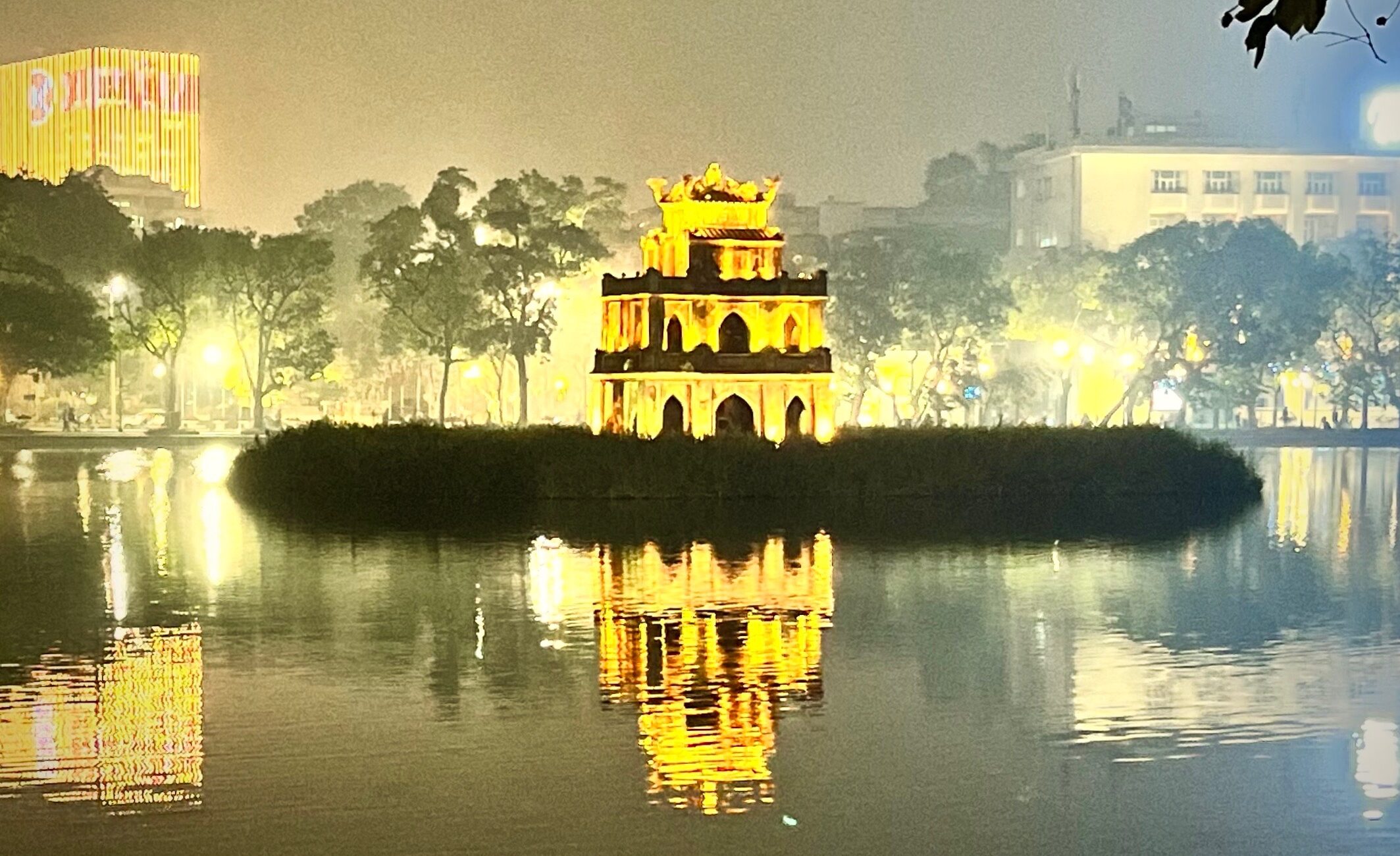
There is much to recommend Hanoi as a vibrant tourist destination. But it is also one of the world’s most polluted cities. Six million motorbikes and two million other motor vehicles have been registered in Vietnam’s capital. Imagine all the exhaust and gasoline fumes from those mopeds and scooters co-mingled with the sweet, spicy and herbal smells of street kitchens and cafés. It’s a pungent and not very healthy blend. But for a couple of days I can stomach it, because of the sheer energy that the city exudes, which makes me care a little bit less about being poisoned, slowly but surely.
Why go if you risk getting exposed to large amounts of carbon monoxide? My main argument would be that Hanoi is so vibrant. It still feels like a place where not every nook and cranny has been explored by Westerners.
Vietnamese people are in general very friendly and helpful. The food is ‘super’-tasty, varied and cheap, the local coffee is robust and even eggy, if you opt for that curious alternative (see below under recommended cafés). Hanoi rates highly with a trendy crowd, but we (I traveled with wife and two children) experienced no queues to visitor attractions. However, there’s a drawback thanks to (no thanks) social media’s influence: you’ll now have to queue to get into some in-vogue cheap eats. Don’t worry, there are plenty of alternative food options, not yet ruined by influencers. Instead of following screen recommendations I urge you to let your nose and eyes be your guide.
Surprisingly many grand building from the French colonial period have survived, but American, Chinese and Soviet-style architecture is also detectable. Most of the older houses in the centre of town have a very narrow street frontage. Some are no more than two metres wide, but what they lack in width, they make up for in depth and height. These so-called tube houses can stretch a long way back and be as high as seven floors. The reason for this odd shape is that property tax was originally based on the width of the façade.
The Neo-Gothic St. Joseph Cathedral is the most frequently visited French building and Sunday Mass can still attract large crowds. A number of ancient Buddhist temples and pagodas are of great interest and I recommend visiting Ngoc Son (Temple of the Jade Mountain). The temple dominates a small island in the central Hoan Kiem Lake and is accessible by crossing a scarlet, typically Vietnamese, wooden bridge. Go early (before 8am) to avoid tourists and witness the locals offer their edible and liquid gifts to the revered General Tran Hung Dao, who repelled several Mongol invasions in the 13th century. A separate building houses two massive stuffed turtles in special glass cabinets. They are related to the golden turtle that lent his magical sword to Emperor Le Loi, who subsequently defeated the Chinese invaders in the 15th century. The general returned the sword to the turtle who disappeared into the depths of the lake with it. It’s all very Excalibur, but there’s no stunning Lady in the Lake, instead this myth serves up a rather ugly giant tortoise.
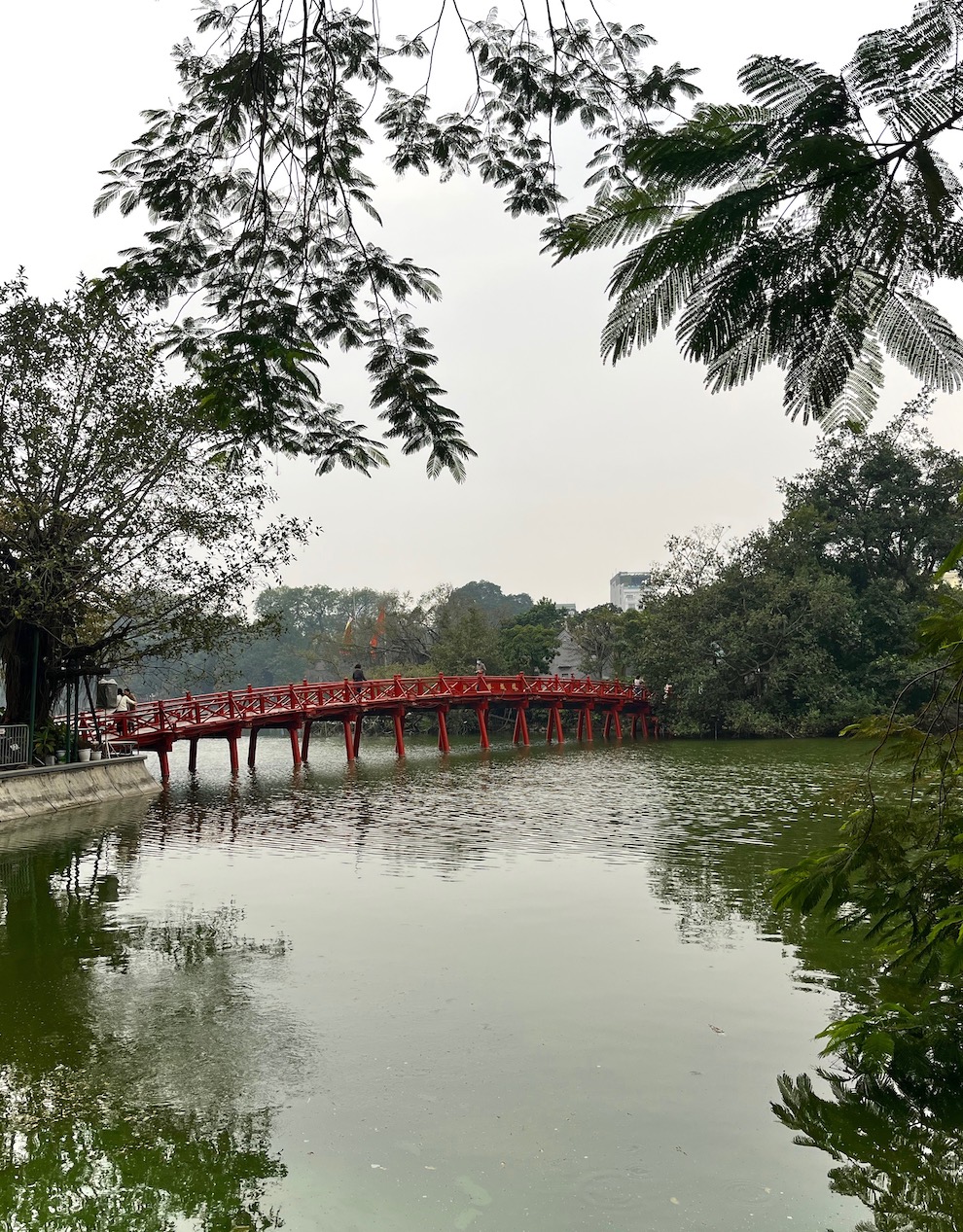
There is much activity around Ho Hoan Kiem in the morning. Westerners jog, while the locals prefer to work on their prefrontal cortex activity with the help of Tai Chi. By 9am the vendors are in position with their wares, ready for the tourists. They don’t just sell old tat, I love the intricately made large pop-up greeting cards that you can buy, after some bargaining, for as little as £1.30.
When the evening falls the surroundings of the lake really come alive. You can join in with groups of (mainly) middle-aged Vietnamese women moving perfectly in unison to Western and local music. Alternatively you could challenge some old geezer to a game of chess. Or sit on a bench with a cuppa green tea or strong sticky rice wine and stare at the lit-up Turtle Tower (Thap Rua), one of Hanoi’s most iconic buildings. The crumbling, but not particularly ancient structure sits on a tiny island and takes on a golden sheen at night. While contemplating the peaceful scenery I imagine the mythical golden turtle re-emerging from the lake., disguised as a lady, holding a glimmering sword.
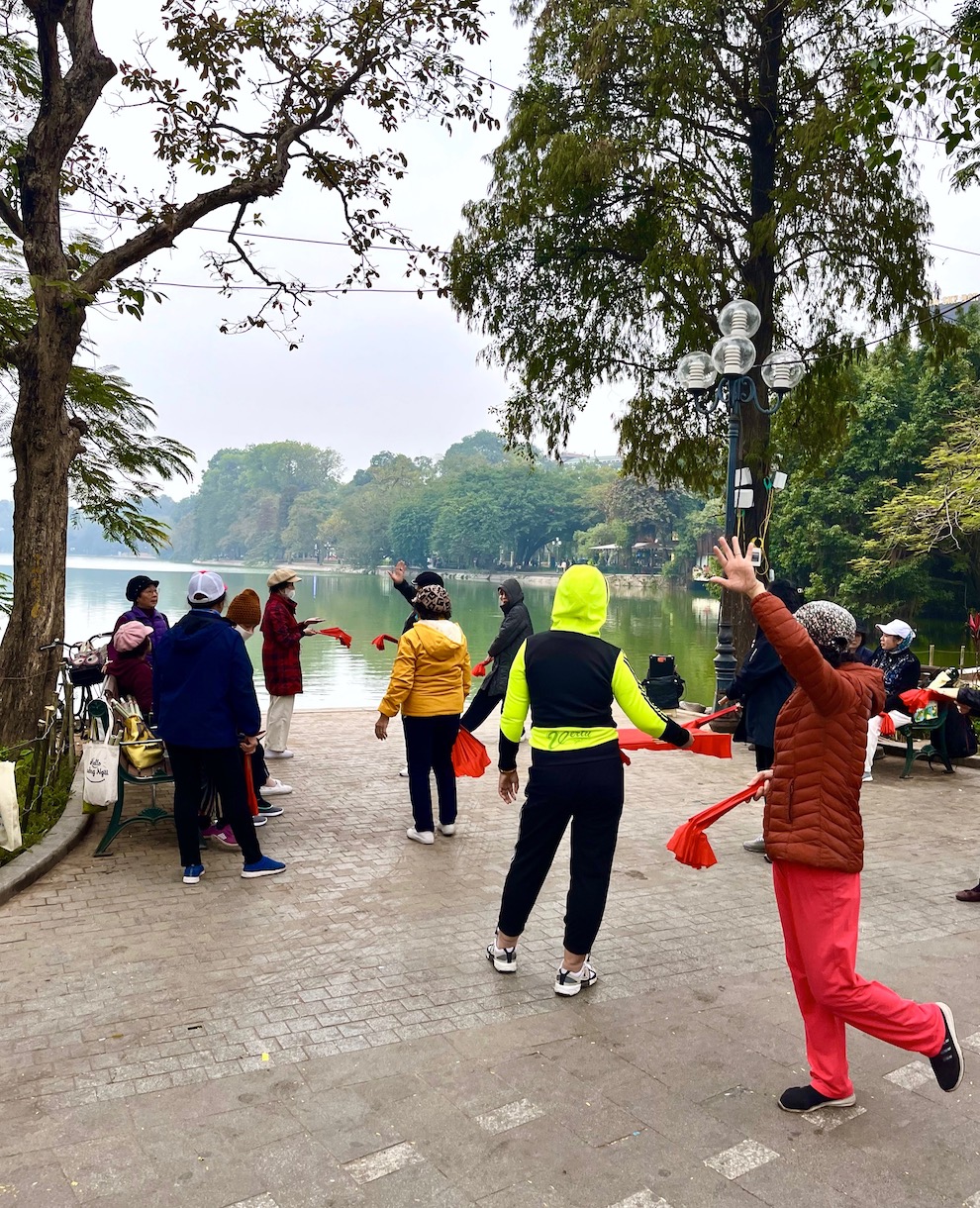
In the last century Vietnam had to deal with French colonialism, was cut in two halves, endured several wars, drove out the Americans, invaded Cambodia, relied too heavily on Soviet support and in the 90s never came to terms with the political realities of perestroika. Vietnam battled with corruption and its leaders were reluctant to reform the country’s political institutions. But this century Vietnam has dealt with many of its political and economic problems and also integrated fully into the global economy, partly thanks to improved relations with the United States and China. Vietnam positioned itself as a manufacturing hub and during the Covid-19 pandemic, when Chinese trade was seriously disrupted, it successfully established itself as an alternative (to China).
The Vietnamese are clearly a resilient lot and colonialism, poverty, war and economic crises have not managed to break the defiant spirit of the people. If you want to get a quick insight into what the Vietnamese had to suffer to achieve independence, I recommend a visit to Hoa Lo prison. The museum’s text panels are rather propagandist and not always honest, but it’s still a humbling experience. The French built the prison in the late 1800s and this is where they locked up the most dangerous Vietnamese patriots in horrific conditions. The cells were painted black and the windows were tiny, temperatures during the winter and summer were often unbearable. The French doled out punishments and torture on a regular basis. The guillotine (originally there were two) on display and the cells on death row speak for themselves. In the 60s captured American airmen were also held here (including John McCain, who later became a Republican senator) and they sarcastically referred to the prison as the Hanoi Hilton. What’s not mentioned is that the Vietnamese interrogators also resorted to torture of American prisoners. But following president Ho Chi Minh’s death in 1969, the treatment became more humane. All the imprisoned aviators were placed in Hoa Lo and allowed to meet and exercise together. In January 1973 the repatriation of the nearly 600 American POWs started and three months later the prison was empty.
Enter ‘Hanoi Train Street’ into your search engine and immediately hundreds of videos will pop up of people standing next to a train track running through a narrow street lined on both sides with cafés. The videos show a stonking big locomotive with passenger carriages or a goods train passing through the street, barely half a metre from the café tables. The tourists standing or sitting along the track, take selfies or film this twice daily event, and post the result on social media. It’s pretty mad and dangerous, but you quickly find out that traffic safety isn’t an issue of real concern in Vietnam. As a pedestrian in the Old Quarter you are much of the time forced to walk on the road because footpaths are (apparently) intended for vendors to set out their stalls or function as a safe haven for hundreds of thousands of parked motorbikes.
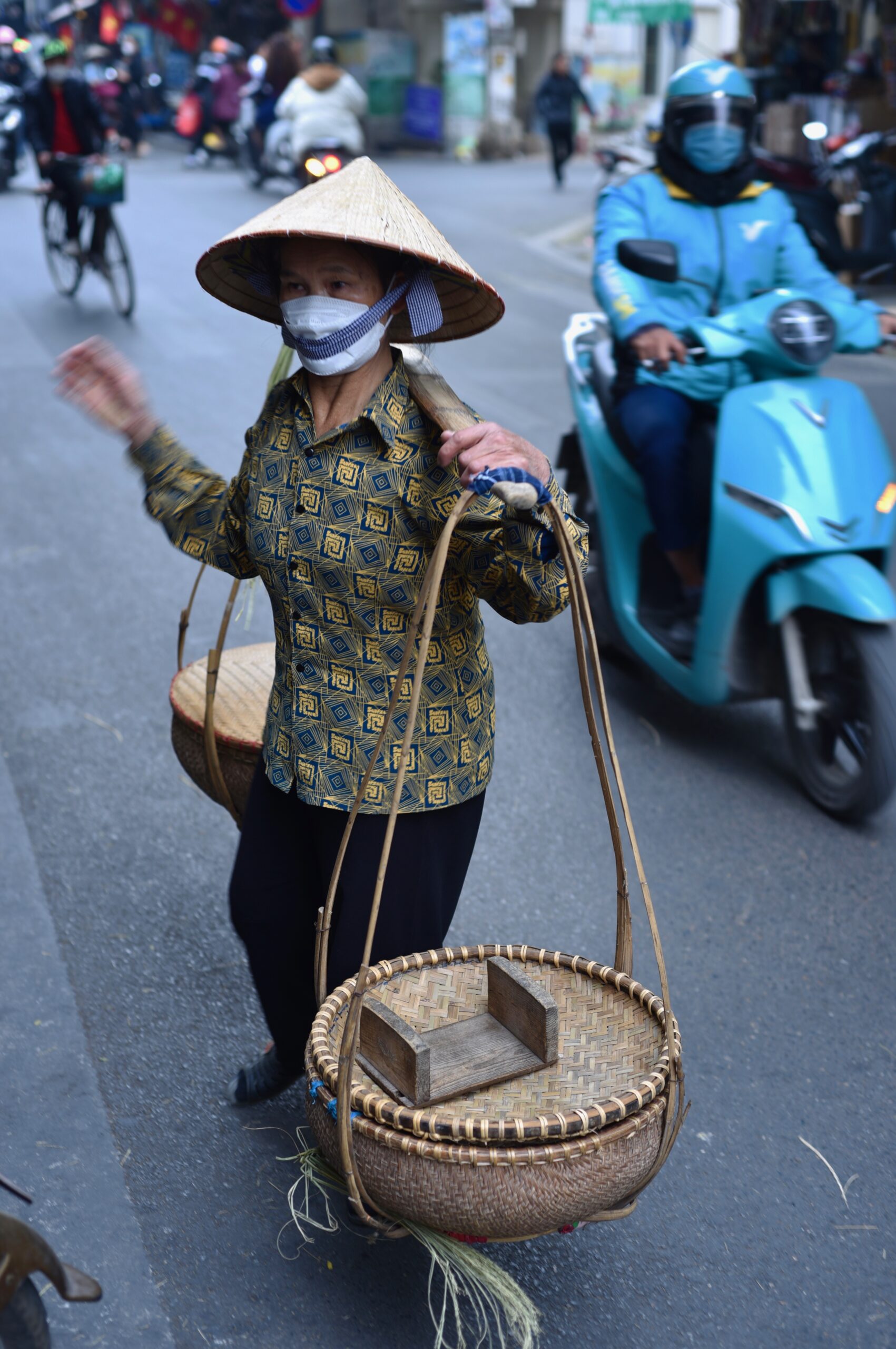
The traffic in Hanoi is part of the whole tourist experience, but you will have to adapt and need to learn how to cross a road, without fear, while swarms of two-wheelers head towards you, seemingly with no intention to stop. You’ll quickly realise that Pan-European zebra crossing rules don’t apply in Vietnam. Judging by how Vietnamese people respond to those white stripes on the road, they might as well be astronomical markers or Peruvian Nazca lines.
If you can’t find any traffic lights nearby, the following rules for crossing the road in a Vietnamese city apply:
when you spot a small gap in the flood of vehicles coming towards you, quickly make your move. Be brave and start walking across the road in a straight line, with your mind focused on one thing only, reaching the other side. Do not stop or walk backwards. avoid eye contact with bikers. They will skillfully swerve around you and occasionally they’ll beep at you. Cars will stop, if necessary. After a few attempts this method will feel as natural as swatting away swarms of pesky flies. I don’t recall coming across road rage on any of my 4 previous visits to Vietnam. People are in general so much calmer in Vietnam than in the West and not prone to anger in public places. To show anger in public mean you lose face and that is to be avoided at all cost.
The bike population tends to wear face masks, that offer a little bit of protection from the pollution. The Vietnamese government has asked five major cities to come up with plans to minimise congestion and intends to ban motorcycles in most inner districts by 2030. Vietnamese people don’t seem to be too concerned that this is a realistic plan as public transport has so far been conspicuous by its absence. The explosive population growth over the last 20 years has on the one hand made Hanoi into one of Asia’s most dynamic cities, while at the same time making it one of the most polluted.
This was my second visit to Hanoi and once more the sun rays never pierced through the grey clouds. With the current emissions of carbon dioxide in Hanoi, I figure the only time you’re likely to see the sun breaking through the rice gruel clouds, is during the Tết holiday (Vietnamese New Year) when most motorcyclists travel to the countryside.
WHERE TO GO FOR:
COFFEE
Vietnam is the world’s largest producer of robusta coffee beans (originally introduced by French colonists). Most coffee shops in Europe serve arabica coffee, but if your daily intake at home is instant coffee, it is nearly always made with robusta beans. The taste is stronger, more bitter and earthy. Robusta also has a much higher caffeine content. Hanoi has its own coffee speciality called Cà phê trung, which is a combination of robusta coffee, sweetened condensed milk, vanilla extract and egg yolk. Yes, it does taste more like a dessert than a wake-me-up brew. For a memorable egg coffee experience head to Loading T (www.loadingtcafe.com/) in the Old Quarter. The café occupies the upper floor of a villa where the distressed look is enhanced by French music. Vietnamese people prefer Blackbird Coffee (5 Chân Cam, Hoàn Kiem, Hanoi, Vietnam), across the road from Loading T. It’s a straightforward place with a modern vibe, but good for people watching.
BEER
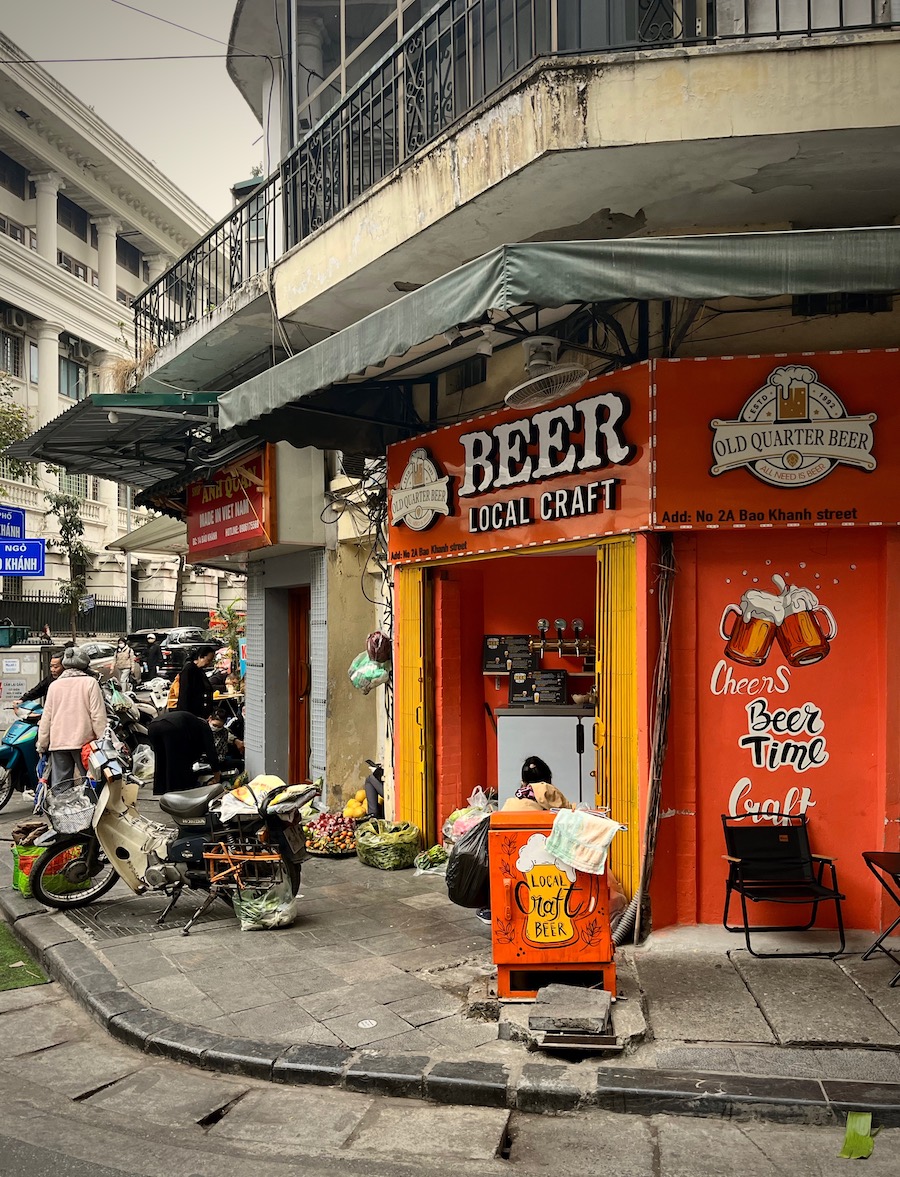
The Vietnamese also love their beer (again thanks to the French!). In Hanoi they seem to prefer their beer fresh, un-pasteurised, brewed and served on the same day. This is the Bia Hoi variety. The Vietnamese are also pretty good at imitating Czech and German style beers, and Hanoi and Ho Chi Minh City are Asia’s craft beer capitals. Small beer bars can be found everywhere in the tourist district.
COCKTAILS
There are plenty of interesting looking cocktail bars in Hanoi. Try them out during the dirt cheap happy hour. My recommendation is the little known Bo/en gin cocktail parlour ( 2nd Floor, 14B Lò Sũ, Hoàn Kiếm, Hanoi, Vietnam) next door to a more famous cocktail establishment (Leo’s). Here you can study pinned and mounted butterflies, as well as medicinal plants preserved in alcohol and acid while sipping a Sex on the Beach. Yes, it’s a bit like having drinks at the Natural History Museum with the lights turned down low, and that was exactly the intention.
HOTEL
This may sound like a paid promotion, but the helpfulness and hospitality of the personnel at L’Signature hotel & spa (www.lsignaturehotel.com) was exceptional. We (2 adults and 2 children) had originally booked an apartment with a kitchen just outside the Old Quarter. But when we arrived early in the morning after a ten-hour flight at the address, they had no knowledge of our booking and all the rooms had been reserved. It turned out that we had been scammed (luckily no money lost). We quickly had to find an alternative. L’Signature, based in the Old Quarter, just 200 metres from Hoan Kiem Lake, offered two rooms, upgraded us upon arrival and made the large double rooms available early so we didn’t have to wait around for too long. They also gave us a very generous late check-out. All this was done for a bargain price. The hotel offers an excellent buffet breakfast and has, like many other hotels in the centre of town, a roof terrace with a restaurant and bar.

